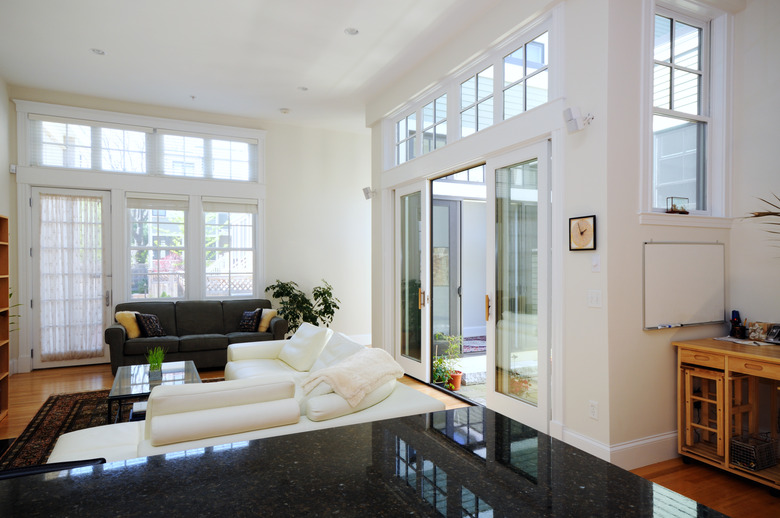How To Heat A House With High Ceilings
A house with high ceilings makes a grand appearance, but it can also put a strain on your heating and cooling system to keep your home comfortable. All of the heat in the room naturally rises to the ceiling, leaving the air a lot cooler down low where you spend your time. Creating more heat and finding ways to push the heat back down toward the floor can help your high-ceiling rooms feel more comfortable.
Seal the Gaps
Seal the Gaps
Keeping any home warmer is much easier when it's energy efficient, insulated and well-sealed. If your room with high ceilings features lots of windows, you could be losing heat through those areas. Installing energy-efficient windows can improve heat retention and make the room feel warmer.
Look for drafts around windows that can indicate gaps and leaks. Sealing those gaps with window and door caulk holds in more warmed air and prevents cold outside air from blowing into your room. You can also install window insulation kits if some windows are particularly troublesome. Doors and openings for things like utilities can also leave gaps that make your home feel cooler.
Another possibility would be to call your utility company. Some utility companies offer energy conservation programs. Some may call it a home energy saving program or audits. These programs or audits can offer professional assessments that will help find energy losing leaks and help seal them up at little to no cost.
Use Your Ceiling Fans Properly
Use Your Ceiling Fans Properly
Ceiling fans can be a useful tool in keeping your home warm in the winter even though they're often thought of as being used for cooling. Hot air gravitates toward your high ceilings, but a ceiling fan can help push it back down toward the floor. Changing the ceiling fan direction for winter to a clockwise motion helps force the warm air downward. You can easily switch the fan direction to maximize its effects for each season.
Redirect Heat to Colder Rooms
Redirect Heat to Colder Rooms
High ceilings in certain rooms can cause uneven heating. High-ceiling rooms might feel cold since the hot air congregates near the ceiling. Other rooms might feel comfortable or even too hot. Redirecting the heat can create a more balanced temperature throughout your home.
Closing off vents completely in certain rooms can cause pressure to build up and can potentially cause HVAC system damage. Instead, partially close the vents to the rooms that are too hot or that don't need to be heated.
You can also adjust the HVAC dampers in the ductwork to redirect the heated air closer to the furnace. You can adjust how open these plate like structures are inside the ductwork, controlling the flow of air to different parts of the home. Fully open the dampers to the rooms with high ceilings that feel cold. Close the dampers partially to the rooms that get too hot or can handle having less heated air.
Capture More Sunlight
Capture More Sunlight
Sunlight pouring into your windows brightens your room and can help heat the space slightly. If you have a room with high ceilings and tall windows, use window coverings that you can open fully to let in the full amount of sun. After the sun stops shining, closing the window coverings can help hold the heat inside. Choose heavy, thermal window coverings to provide an extra layer of insulation over your windows.
Install Radiant Floor Heating
Install Radiant Floor Heating
Since warm air rises, putting heat beneath your feet can generate warmth lower in the room. A radiant floor heating system makes you feel warmer since your feet touch the warm surface whenever you walk in the room. Some of the heat also radiates up into the room, warming the air above the floor. It also warms other objects in the room, like your furniture, to make all of the surfaces you touch feel warmer.
Radiant floor heating can either use electric heating elements or pipes that carry heated water around the room. The heating component goes under your flooring, so you can't see it. Ceramic tile, stone, laminate and hardwood flooring all work well with radiant floor heating systems.
